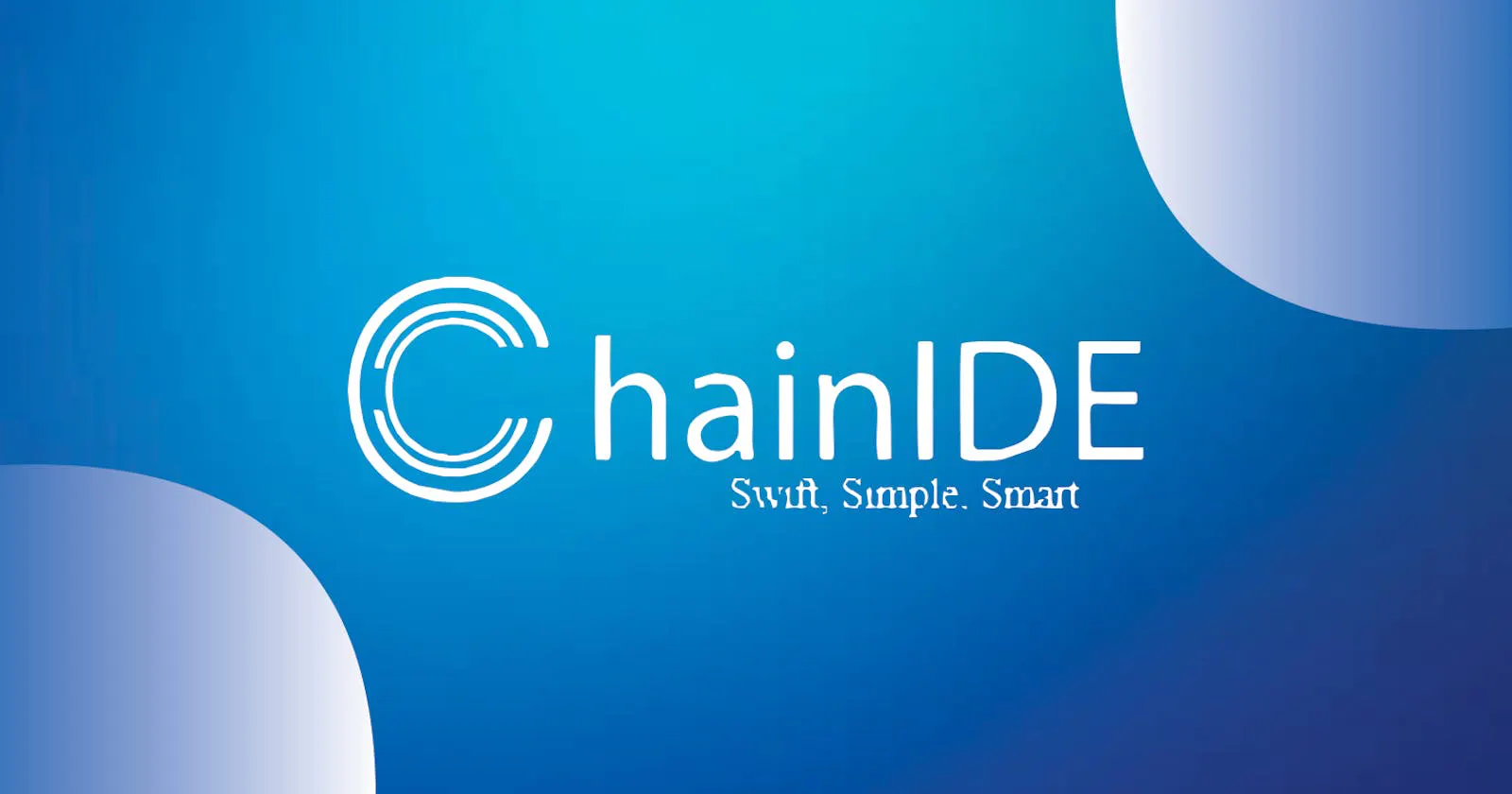History of ChainIDE and road map for 2023
 Paschal
PaschalTable of contents
- First, let's discuss what an IDE is.
- Introduction to ChainIDE
- Inspiration behind ChainIDE?
- Who’s the team behind ChainIDE? Tell us more about the Matrix Group.
- How did people get to know about ChainIDE in the very beginning?
- What are the differences between local and cloud-based development
- What's the difference between ChainIDE, Remix, and other cloud-based IDEs
- ChainIDE's Ecosystem, Events, and Hackathons
- ChainIDE's plans and roadmap for 2023
- What’s the ChainIDE incubation program?
- What’s the Membership System? And what can it be used for?
- Useful Link

Hello guys, how are you all doing? Today, we are going to talk about the history of ChainIDE and ChainIDE's road map for 2023.
First, let's discuss what an IDE is.
An integrated development environment (IDE) is software for building applications that combines common developer tools into a single graphical user interface (GUI). An IDE allows developers to start building new applications quickly because multiple utilities don’t need to be manually configured and integrated as part of the setup process. Developers also don’t need to spend hours individually learning how to use different tools when every utility is represented in the same workbench. This can be especially useful for onboarding new developers who can rely on an IDE to get up to speed on a team’s standard tools and workflows. In fact, most features of IDEs are meant to save time, like intelligent code completion and automated code generation, which removes the need to type out full-character sequences.
Introduction to ChainIDE
ChainIDE is a cloud-based integrated development environment (IDE) for building applications for Ethereum, Polygon, Binance Smart Chain, Nervos, and a host of other chains. It has an interactive, easy-to-use environment and ready-to-use plugins that shorten development time and costs. Currently, ChainIDE supports more than ten Blockchains which include EVM blockchains and non-EVM blockchains.
Inspiration behind ChainIDE?
When the team behind ChanIDE first started their business in 2019, they found that developers were scattered in different blockchain ecosystems. When they want to switch to a different blockchain to develop new applications, it takes a lot of time to set up a local development environment, which is very time-consuming and laborious. So they decided to introduce ChainIDE, integrated ChainIDE with all the popular and most commonly used blockchains. so users don’t have to set up a local environment whenever they want to create an application for a different blockchain. So, ChainIDE could help users save time and resources such as storage.
Who’s the team behind ChainIDE? Tell us more about the Matrix Group.
The team behind the ChainIDE is named Matrix Group which includes White Matrix & Matrix Labs. These two companies co-worked to create ChainIDE in 2019. Matrix Group is a passionate group of blockchain enthusiasts. The core members of the Matrix Group met in 2017 in the Ethereum ecosystem. The team started as a group of students, tutors, and professors from prestigious Canadian universities, such as the University of British Columbia, the University of Alberta, Dalhousie University, and the University of Waterloo. After graduation, some members went on to hold technical lead positions at well-known enterprises like Amazon and Alibaba, and the rest continued in Matrix Group. The team has since grown to over 50 members worldwide. The team has established blockchain joint laboratories with many well-known universities in the world, including the University of Alberta in Canada, the Chinese University of Hong Kong in Shenzhen and so on. Every year the team introduces interesting projects in Web3 and publishes academic papers, some of which are accepted by world-renowned journals and magazines such as IEEE.
How did people get to know about ChainIDE in the very beginning?
In 2019, ChainIDE was the first and only IDE that supported Facebook Libra blockchain. At that time, it was the first IDE in the world to support the MOVE language, which was supported by Libra at that time, and Libra is now being supported by the Aptos Blockchain and some other blockchains, and it got the attention and recognition of Facebook that time. That’s how ChainIDE got popularity among the blockchain ecosystem and got the first batch of users who developed dApps based on the MOVE language.
What are the differences between local and cloud-based development
The local development environment needs to be set up by the developers, but for the cloud-based development environment, everything you need for development is already set up for you to use, so you do not need to install any software and do other setups before building your projects on ChainIDE. Furthermore, Local based development environment stores your project on the local storage, so if anything happens to your operating system, then all your projects will be lost, however, the case is different for a cloud-based development environment which stores your projects on the cloud and allows you to access them anytime and anywhere you want.
What's the difference between ChainIDE, Remix, and other cloud-based IDEs
Remix is one of the most popular cloud-based smart contract IDEs, it is simple to use, and also has a one-click deployment and debugging. It also has very rich features for solidity. Remix is EVM (Ethereum visual machine) only. It does not support multi-chain blockchain, but that's totally understandable because it's basically kind of backed by the Ethereum foundation. It has no front-end development feature, and it's running purely in the browser, which means that if you want to do a full stack development that relies on NPM node runtime, then you have to use some other development tool to help you finish the entire development process. So that's kind of a throwback of it, and it requires a lot of complicated configuration before starting the actual development.
However, you can develop a full-stack application using ChainIDE, it supports both NPM node runtime and solidity code runtime. ChainIDE also provides customized features and plugin systems, and the fourth thing is the Ecosystem, ChainIDE gives you more useful services and activities to help more developers to build and incubate their applications.
ChainIDE's Ecosystem, Events, and Hackathons
ChainIDE has more than 30k active users right now, and more than 65 registered tutors that include university professors, Web3 project founders, and VC researchers. In the past three years, ChainIDE has held more than 10 developer boot camps and hundreds of small online workshops; Incubated more than 20 projects. For more information, you may check eco.chainide.com
ChainIDE's plans and roadmap for 2023
In 2023, ChainIDE plans to continue providing most IDE services for free, while some IDE services will be moved to the paid version. ChainIDE also plans on incubating more web3 projects into its ecosystem, and conduct more hackathons, Boot camps, and seminars to get more developers into blockchain development. At the same time, ChainIDE will connect with people in the Web3 industry of the MENA region. Middle East, Turkey, and North Africa. Bring the latest web3 courses to developers in these areas and cultivate local web3 developer talents. At that time, we will also launch ChainIDE’s incubation program and Membership System.
What’s the ChainIDE incubation program?
ChainIDE established an incubation funding program, where developers in the Web3 space can submit their projects through our funding portal, and we will review these projects; select high-quality and potential projects to provide financial and technical support. We will help them link to the industry resources that ChainIDE already has, including: public chain, media for promotion, investors for funding, VC, etc.
What’s the Membership System? And what can it be used for?
The Membership System is what ChainIDE designed to motivate and reward their users. Users can get corresponding points by completing our weekly and monthly activities. Similarly, if you are an active user of ChainIDE, they will also reward you with corresponding points. These points can be used to redeem some ChainIDE physical Merch, such as slippers, hoodies, Mugs, and so on. The Membership System is also related to the reputation system we hope to launch in the future.
Useful Link
Subscribe to my newsletter
Read articles from Paschal directly inside your inbox. Subscribe to the newsletter, and don't miss out.
Written by

Paschal
Paschal
A zealous full stack Blockchain developer with three productive years of test-proven accomplishments and a commitment to pursuing a career in tech.